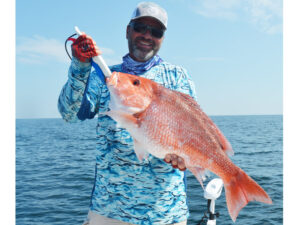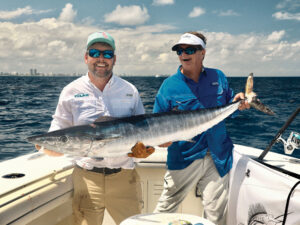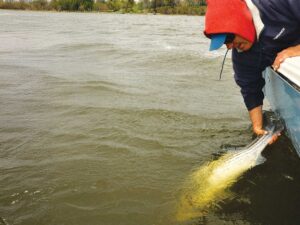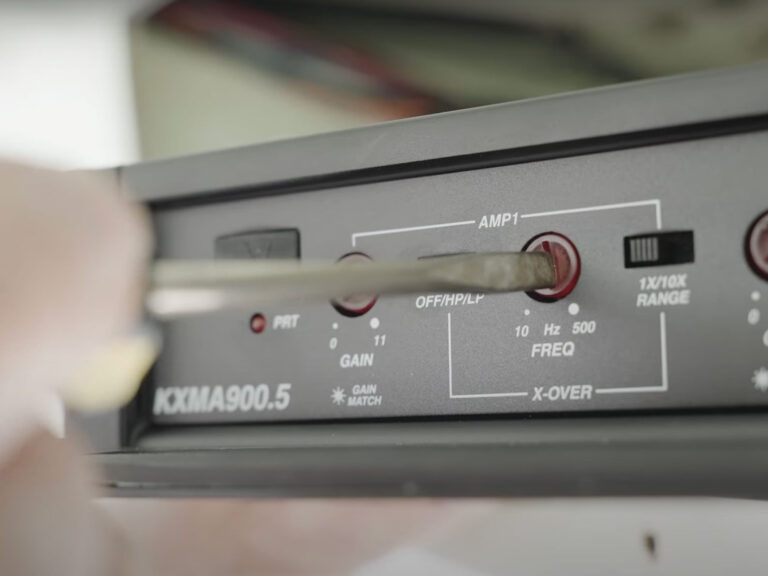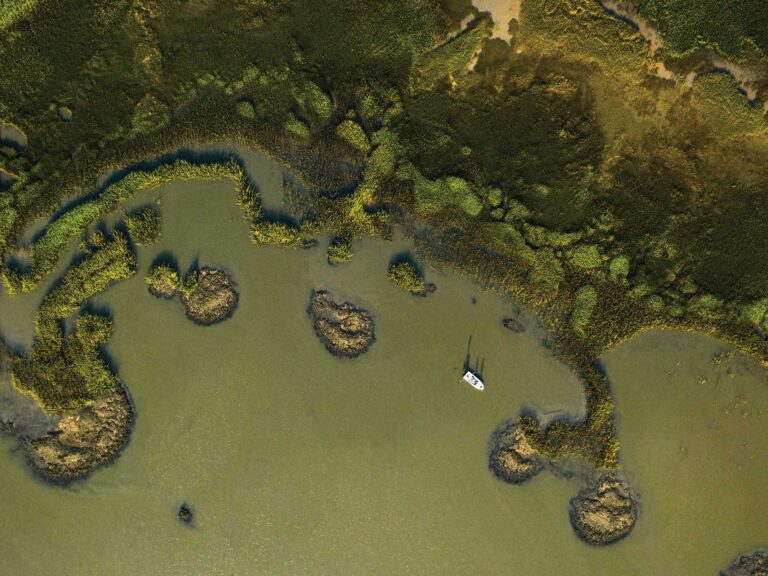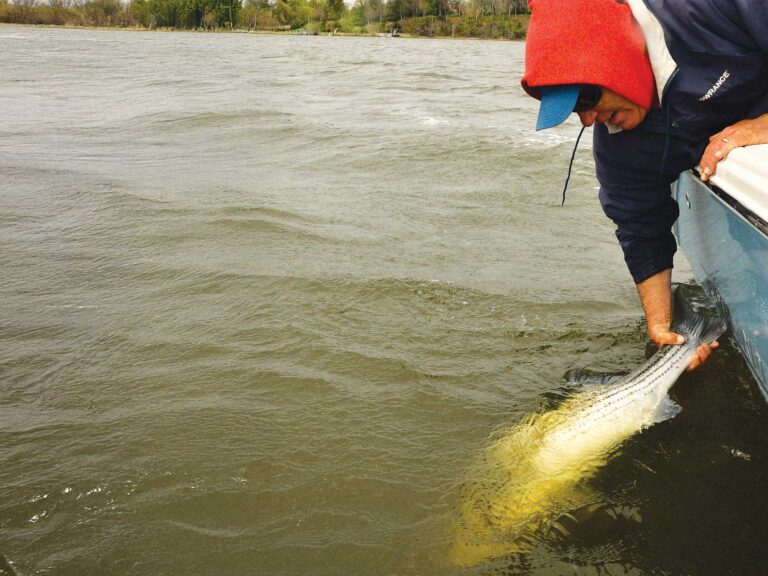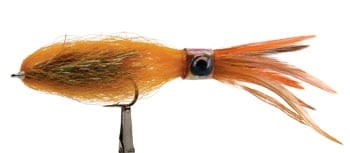
For years, anglers relegated squid patterns to the back of their boxes as “specialty flies,” reserved for obvious squid runs. However, as bass in my home waters of New York Harbor coughed up squid after squid throughout the season – even during times when other forage was more obviously present – we rethought our bias.
The result has been more and bigger fish – and a bunch of fun.
Squid present a design challenge for fly tiers. Their anatomy, coloration and movement differ from other baits. Yes, they posses an elongated shape similar to some finfish, but the parallels end there.
The Fascinating Squid
Lengthwise, a squid is roughly two-thirds mantle and one-third head and tentacles. The head features disproportionately large silver eyes, which are widely separated and sport big black pupils.
Squid have a fascinating means and manner of movement. They suck water into their mantle and expel it out a siphon in a fast, strong jet. The siphon’s direction is easily changed, so squid can swim both backward and forward with ease. A feeding squid might swim tentacles-forward, but when agitated, it will use its siphon to jet mantle-forward, with head and tentacles trailing.
Because fleeing prey trigger a striper’s feeding urge – and because schooling squid often swim with their tentacles rearward – most squid flies are constructed to move mantle-forward.
Squid have an ancestral internal shell called a pen, which functions like a stiff, semiflexible backbone. It keeps a squid’s mantle fairly rigid when swimming, while the tentacles flow freely. Along the mantle’s sides, a pair of willowy fins act like rudders as the squid glides to and fro.
Coloration is complex and variable. Pigment cells called chromatophores allow squid to change colors instantly, and they often shimmer at will in shades of pink, orange, rust, purple, blue, red, gray and tan. The colors often appear as vivid dots against a translucent, milky white or gray background. The dorsal surface of the squid is usually more brightly colored than its paler underside.
Creating the Squid Pattern
But how do we make one of these things? I puzzled over many designs before coming up with something that seemed true to the real deal.
The mantle always reminded me of an elongated and translucent blimp or cucumber, rounded and a little thicker in the middle. A popular trout fly, Gary LaFontaine’s Emergent Sparkle Caddis Pupa, provided inspiration. The pupa is constructed of a bubble of synthetic Antron yarn surrounding a dubbed body, yielding a miniature blimp similar to the squid’s mantle.
On a larger scale, Kinky Fiber or natural yak hair provides similar results; when these fibers are reverse tied with Bob Popovics’ Hollow Fleye technique over a body wrap of any of the flash yarns (Estaz, polar chenille or Palmer chenille), the result is a translucent oval with an inner glow reminiscent of a real squid.
The head and tentacles remained a challenge, however. First, to keep the proportions true and maximize tentacle movement, the head needs to be placed behind the bend of even a long-shank hook. Second, a real squid’s eyes do not lie back-to-back, like most imitations, but are set widely apart by the cylindrical head to accommodate the full spread of tentacles.
Likewise, the tentacles don’t radiate out from a single point but rather extend side-to-side like the fingers of a hand. The only close models I had seen were Popovics’ offshore poppers and Rear Floating Squids, in which saddle hackles are glued around the circumference of a foam cylinder.
To get the same effect without the bulk of foam, I needed a hollow ring to which I could attach saddle hackles, fur or other materials that replicated tentacles. Siliskin – or better yet, Brad Buzzi’s Gooey Body – provided a perfect solution.
The saddles are laid onto the adhesive side of a Gooey Body strip, drizzled with flexible glue (Plasti Dip or Softex), and the entire assembly is then rolled into a ring and slid onto the backside of the mantle. Place eyes on either side of the ring, and glue with Plasti Dip. The result is incredibly durable and can’t be removed without tearing the hair itself.
This head assembly produces widely separated eyes, and the saddles flow freely and independently around a circle, moving with every little twitch of current and mimicking the most animated area of a squid.
The Emergent Sparkle Squid does take a number of steps to tie, but it’s a simple tie with readily available materials.
If the “full dress” version is more of a project than you want to undertake, here’s a simple alternative: a four-step tie that avoids any separate construction of the head. Just tie a long bunch of Kinky Fiber along the hook shank, wrap the shank with a flashy yarn, and fold the forward-facing fibers back over the body in a Hollow tie. Then gently wrap a ring of Gooey Body around the fibers behind the bend of the hook, glue on some eyes, and trim the tentacles to a tapered point.
You now have a translucent, glowing mantle, conspicuously separated eyes and some sweeping tentacle fibers. Toss into a frothy rip, and you’re good to go.
Materials
HOOK: Long-shank saltwater
THREAD: Monofilament
OUTER BODY: Yak hair or Kinky Fiber
INNER BODY: Palmer chenille or Estaz
HEAD: Siliskin or Gooey Body with stick-on or 3-D eyes
TENTACLES: Saddle hackles or tapered fur
| Step 1: Lay eight to 10 saddle hackles on the adhesive side of a Gooey Body strip, and drizzle Plasti Dip on the stems to glue them in place. |
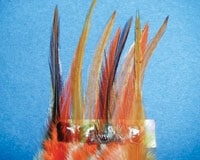
| | Step 2: Roll Gooey Body into a circular ring, and trim off hackle stems. Eyes can be affixed now or later.|
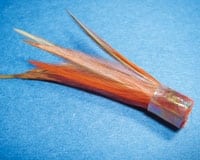
| | Step 3: Fasten a long bunch of yak hair or Kinky Fiber along shank, with 2 inches extending to the rear and 5 to 6 inches extending forward. Make sure the hair encircles the shank 360 degrees.|
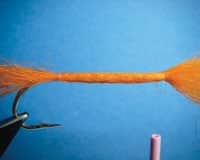
| | Step 4: Wrap Palmer chenille along full length of the shank.|
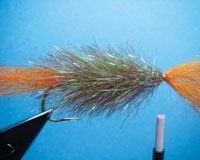
| | Step 5: Push forward-facing fibers back over the body and post backwards with a dam of thread at the hook eye, as in Popovics’ Hollow Fleye.|
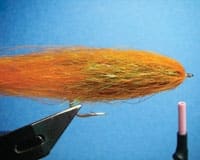
| | Step 6: Reverse hook in vise, gather fibers trailing off hook bend into a point with temporary thread wraps and half hitches, and slide the head assembly over trapped fibers. (The head won’t slide easily over loose fibers.)|
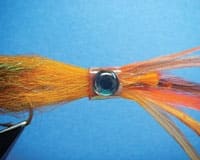
| | Step 7: Slide half hitches off fibers, which will spring out and temporarily hold the head in place. Gently slide head to desired position behind hook bend and apply Plasti Dip to edge of head assembly and around eyes.|
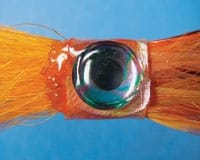
| | Step 8: The Emergent Sparkle Squid is complete.|
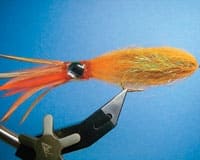
|

